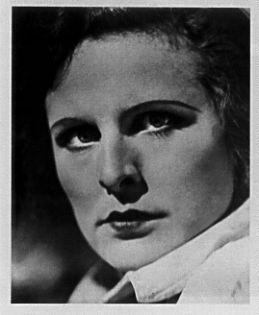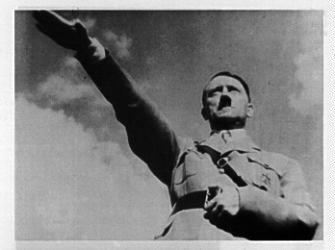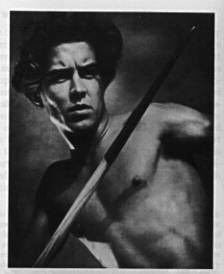
LENI RIEFENSTAHL, TRIUMPH OF THE WILL (TRIUMPH DES WILLENS) (1935) 1HR 49MINS
Note: This film guide is part of a collection of film guides on history, politics, and war.
|
 |
THE DIRECTOR: HELENE BERTA AMALIE ("LENI") RIENFENSTAHL (1902-)
Life
German actress and film director who came to prominence during Nazi period as director of propaganda documentaries. Attended Russian Ballet School in Berlin; worked as stage dancer in early 1920s; 1st film contract as dancer in film Der heilige Berg (1926) directed by Arnold Frank; stars in several of Frank's so-called "mountain films" and from him learns the ropes of filmmaking; forms own production company in 1931 and directs first film Das blaue Licht (1932) which results in her first meeting with Hitler; when Nazis come to power in 1933 LR is appointed by Hitler to post of "film expert to the NSDAP" and is commissioned by AH to film Nazi rally Sieg des Glaubens (1933); in 1934 commissioned by Nazis to film Nuremberg rally which results in Triumph of the Will (1935); in 1936 films Berlin Olympics - Olympia (1936). Imprisoned 1945-48 by Allies for her pro-Nazi activity and finally released in 1952 when charges against her are dismissed. Following trial LR tries to rebuild her film career (documentaries in Africa) but is unsuccessful. Commissioned by London Times to film Munich Olympic Games in 1972.
Films
- Das blaue Licht (1932)
- Sieg des Glaubens (1933)
- Triumph of the Will (1935) and Tag der Freiheit: unsere Wehrmacht (1935)
- Olympia (1936)
- Tiefland (1944/1954)
THE FILM
Meaning of the Title
Whose will "triumphs"? Presumably Hilter's as the Nazi takeover of power in 1933 is consolidated by mass demonstrations of popular support at staged rallies like the Nuremberg Party "days" at the party Congress in 1934. LR argued that the triumph was the triumph of a strong Germany and the triumph of the the will of the new leader (Welch, p. 152).
One of the most controversial and notorious films ever made. Commissioned by Hitler for obvious propaganda purposes but defended by LR as a work of cinematic art
BIBLIOGRAPHY
Reading Guide for Honours Special Subject "Reel History": Leni Riefenstahl and Nazi Propaganda Films
Leni Riefenstahl, The Sieve of Time: The Memoirs of Leni Riefenstahl (1992).
Martin Loiperdinger and David Culbert, "Leni Riefenstahl, the SA, and the Nazi Party Rally Films, Nuremberg 1933-1934: `Sieg des Glaubens' and `Triumph des Willens'" Historical Journal of Film, Radio and Television, 1988, vol. 8, no.1, pp. 3-38. BSL (M) 791.405H673
Brian Winston, "Film in Context: Triumph of the Will," History Today, January 1997, vol. 47, no. 1, pp. 24-28.
Robert Skalr, "Her Talent Was Her Tragedy: An Interview with Ray Müller," Cineaste, 1994, vol. 20, no. 3, pp. 22-23.
David Welch, Propaganda and the German Cinema, 1933-1945 (Oxford: Clarendon Press, 1983).
OTHER IMAGES
Der Fuehrer |
The Aryan Warrior/Athlete |
THINGS TO NOTE
- Is this a "documentary" film made spontaneously while recording an historical event or a carefully staged (orchestrated and commissioned) party propaganda piece?
- The innovative editing techniques:
- her ability to make static images appear to "move" - dull party speeches, endless military-style parades (cutting between speaker, crowd, symbols of NSDAP, camera viewing scenes from many different angles (especially from above))
- the clever contrast of light and dark - stormtroopers night rally lit by torches
- the insertion of Nazi party symbols (eagles, swastikas, flags and banners)
- the architectural images (Speer's stadium, lights, parades, massed crowds)
- The famous opening of the film with Hitler's plane emerging, god-like from the clouds.
- The use of framed shots - a window, Hitler in a window, scenes of crowd, Hitler acknowledging crowd.
- The sense of massed support for AH and the NSDAP - crowds in the street (popular civilian support); military parades of party paramilitary groups; even spades have a symbolic military significance. Event takes place after purge of Ernst Röhm and SA - need to show unity of party.
- The heavy use of symbols - eagles, flags, uniforms, swastikas - often moving without apparent human support in a "forest of flags".
- The depiction of Hitler as the lonely, godlike Messiah - floating above the crowds in a plane or open-top car. The celebration in film of one of the Nazi's major ideas - the "Führerprinzip" or principle of leadership.
- The depiction of the crowds supporting the NSDAP as faceless, undifferntiated, "achitectural" humanity arranged in geometric shapes (coloumns, squares, lines).
- The scenes which were "staged" or "restaged" for the cameras - camermen wearing SA uniforms to "blend in with the crowd".
- How succesful is this film as propaganda? Marked succes in the larger German cities; relatively little success on a popular level. Why? Too "artistic"?
- The "monumental" nature of the event.


